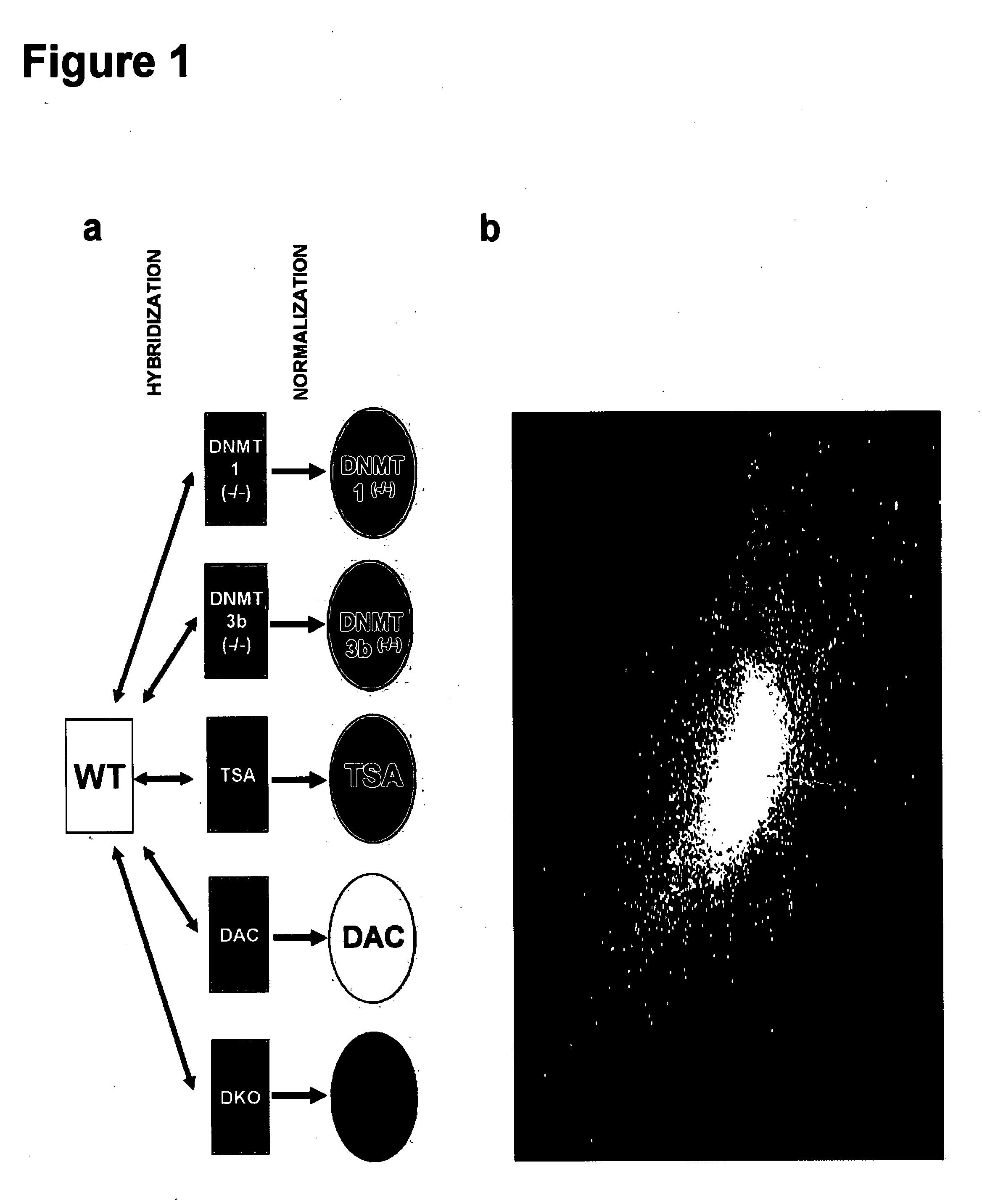Early detection and prognosis of colon cancers
- Summary
- Abstract
- Description
- Claims
- Application Information
AI Technical Summary
Benefits of technology
Problems solved by technology
Method used
Image
Examples
example 1
Materials and Methods
[0090] Cell culture and treatment. HCT116 cells and isogenic genetic knockout derivatives were maintained as previously described (Rhee et al1). For drug treatments, log phase HCT116 cells were cultured in McCoys 5A media (Invitrogen) containing 10% BCS and 1× penicillin / streptomycin with 5 μM 5-aza-deoxycytidine (DAC) (Sigma; stock solution: 1 mM in PBS) for 96 hours, replacing media and DAC every 24 hours. Cell treatment with 300 nM Trichostatin A (Sigma; stock solution: 1.5 mM dissolved in Ethanol) was performed for 18 hours. Control cells underwent mock treatment in parallel with addition of equal volume of PBS without drugs.
[0091] Microarray analysis. Total RNA was harvested from log phase cells using the Qiagen kit according to the manufacturers instructions, including a DNAase step. RNA was quantified using the Nanoprop ND-100 followed by quality assessment with 2100 Bioanalyzer (Agilent Technologies). RNA concentrations for individual samples were grea...
example 2
Results
[0095] In humans, a majority of the 3×107 5-methylcytosine nucleotides are embedded within repeat-rich DNA located outside of genes (Bestor et al.). However, CpG rich islands within the promoter regions of approximately 45% of genes remain primarily methylation free in normal somatic cells (Antequera and Bird). Some predictions suggest there may be hundreds of tumor suppressor genes with aberrant CpG island hypermethylation and transcriptional repression in human tumors (Costello et al., Suzuki et al.). Most, including functionally important genes, remain unidentified. Multiple approaches to screen for such genes have appeared including searches for hypermethylated loci in defined chromosomal regions (Wales et al.), methylation based screens of CpG island subsets (Hu et al., Weber et al.), gene expression profiling (Gius et al.; Paz et al.), and methylation sensitive restriction enzyme dependent genomic screens (Toyota et al., Keshet et al.; Ushijima). Each approach has limi...
example 3
Finding New Markers for Early Detection and Prognosis of Colorectal Cancer
[0105] Using a high throughput real time methylation specific platform, a total of 240 genomic DNA samples have been analyzed out of which 142 samples were isolated from colorectal cancer and 98 samples haven been isolated from normal colorectal tissue. From each sample, up to 1.5 μg of genomic DNA was converted using a bisulphite based protocol (EZ DNA Methylation Kit™, ZYMO Research, ORANGE, Calif.). After conversion and purification the equivalent of 50 ng of the starting material was applied per sub-array of an OpenArray™ plate on the real-time qPCR system offered by BioTrove Inc. using the DNA double strand specific dye SYBRgreen for signal detection.
[0106] The cycling conditions were: 90° C.-10 seconds, (43° C. 18 seconds, 49° C. 60 seconds, 77° C. 22 seconds, 72° C. 70 seconds, 95° C. 28 seconds) for 40 cycles 70° C. for 200 seconds, 45° C. for 5 seconds. A melting curve was created over a temperature...
PUM
| Property | Measurement | Unit |
|---|---|---|
| Digital information | aaaaa | aaaaa |
| Fraction | aaaaa | aaaaa |
| Fraction | aaaaa | aaaaa |
Abstract
Description
Claims
Application Information
 Login to View More
Login to View More - R&D
- Intellectual Property
- Life Sciences
- Materials
- Tech Scout
- Unparalleled Data Quality
- Higher Quality Content
- 60% Fewer Hallucinations
Browse by: Latest US Patents, China's latest patents, Technical Efficacy Thesaurus, Application Domain, Technology Topic, Popular Technical Reports.
© 2025 PatSnap. All rights reserved.Legal|Privacy policy|Modern Slavery Act Transparency Statement|Sitemap|About US| Contact US: help@patsnap.com



